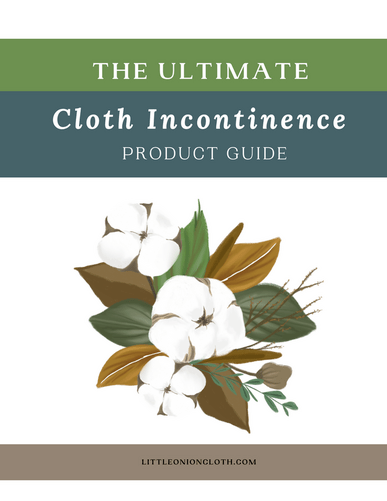How to Use Adult Cloth Incontinence Products
Perhaps you use disposable adult diapers and want to try cloth diapers but have no idea where to start?Adult cloth incontinence products are simple to use. That’s true for both adult cloth diapers and other types of cloth incontinence products. I’d like to show you how they work and how to save a lot of money – you’ll also keep countless disposable diapers out of landfills when you make the switch.
Converting to cloth is an investment that pays off when you put in the time to build a new habit.
Here’s everything you need to know about how to use adult cloth products to manage your incontinence.
Want to know what products are out there?
Find lists for every type of cloth incontinence products in my Ultimate Guide!



Reasons to Use Cloth Incontinence Products
Cost Effective
Using cloth diapers or leakproof underwear saves you a ton of money, even if you don’t sew your own. It’s true that the upfront cost can look intimidating. Cloth products vary wildly in price from cheap to expensive, but you will save money in the long run.
The savings get even better if you sew your own. Regardless of whether you purchase cloth products or make your own, using washable cloth diapers, leakproof underwear, and cloth pads is a great way to save money in the long run.
Eco-Friendly
When you use cloth, you treat your body and the planet with kindness — despite the naysayers saying we aren’t really helping the planet since we have to wash our cloth diapers.
It takes about 500 years for a disposable diaper to decompose. Over 20 billion disposable diapers are thrown into our landfills every year, so it’s a problem worth considering.
On top of that, disposable diapers account for the use of 200,000 trees a year in the United States and 3.4 billion gallons of fuel.
Most cloth products need to be washed our cloth diapers at least every 3 days. If you’re wondering about the amount of water used to grow the cotton and bamboo in many diapers, you can consider synthetic fiber diapers, which take hundreds of years to break down in a landfill.
Kinder to Your Body
Plastic doesn’t breathe. Cloth, on the other hand, is breathable, especially if you use a PUL cover and not a plastic cover. Cloth allows for more air flow. You can also use stay-dry liners that keep the moisture from your body. Switching to cloth has helped many of my customers who experienced diaper rash while using disposables.
Moreover, wearing cloth can make you feel so good about your lifestyle. I hear about the positive changes in my customers’ lives all the time when they find the right cloth product and make the switch. That said, I understand that some people feel good in disposables, and that’s great because everyone deserves to feel good about whatever they’re wearing.
Cloth Incontinence Product Mistakes
Assuming You Need a Diaper
This is a common prejudgement that someone considering cloth products can make. If they investigate, they’ll learn that one of the best things about using cloth incontinence gear is the diversity of products to choose from, including cloth pads, pull ups, briefs and, yes, actual diapers, too.
When you know your flow, which is the quantity and rate at which leakage occurs, then you’ll know which type of product you need.’
Not Knowing Your Proper Measurements
Knowing how to find your measurements before purchasing an item online will assure the item will fit. A good fit is essential to both your comfort and to preventing leaks. So it’s critical that you know how to correctly take your own measurements. The two most common measurements when it comes to incontinence underwear and cloth diapers are:
- Waist
- Hip
And since adult diaper size charts can be confusing from one company to another, knowing your measurements make those size charts much less confusing.
Thinking Cloth Incontinence Products Always Leak
This is one of those myths about adult cloth diapers. Keep in mind that disposables can leak too, but adult cloth diapers can mainly leak for three reasons:
- Bad fit
- Not enough absorption
If you have worn cloth incontinence products before and experienced leaks, here are three questions to consider:
- Did it fit snugly around your waist and legs?
- Did you have enough absorption?
- How long was it worn before it started leaking?
Chances are, one of the above will be the culprit for your leaky product. The only exception is if the item worked amazingly and then it didn’t. The culprit for that would probably lie in your washing routine. Understanding how cloth products work can improve your quality of life.
Types of Adult Cloth Diapers
The thing to keep in mind about the different types of cloth diapers is that there really is no “best” style of diaper or brand of diaper.
1. Flats
These are the proven, old school diapers our grandmothers used. Each is a large, square single layer of fabric you fold origami style to wrap around the body. You can also fold them pad style to use like an insert. Economical and versatile.
2. Prefold
A prefold is a rectangular shaped diaper that has been folded multiple times with the most amount of absorbent layers concentrated in the middle third of the diaper and then sewn down.
Some of these “prefolds” are nothing more than a thin cotton birdseye fabric folded in half with a layer of batting down the center, not a true prefold at all.
True prefolds come with designations like 2x4x2, 2x6x2, 4x6x4, or 4x8x4. These designations refer to the number of layers in each panel of a trifold, with the most layers concentrated in the center panel.
3. Fitted
A fitted diaper is made solely from multiple layers of absorbent materials with no water proof barrier. It features an hourglass shape like disposable diapers with a front closure of either hook and loop or snaps and has elastic bands at leg openings.
4. Contour
A contour diaper sits somewhere between a prefold and fitted diaper. It is shaped in an hourglass silhouette like a fitted but requires diaper fasteners to close them.
5. Diaper Cover
A diaper cover is a waterproof covering used to prevent leaks in cloth diapers like prefolds, flats, fitteds, and pull on diapers. Since it is made solely from water proof materials like PUL or vinyl, it has less chance of leaking.
6. Pocket Diaper
A pocket diaper consists of an outer shell of PUL with a liner of stay dry material that wicks moisture away from the skin. An opening between the shell and liner creates a pocket for absorbent inserts to be stuffed in.
7. AIO
An All In One (AIO) diaper features a waterproof outer shell and sewn in absorbent layers topped by lining fabric that rests next to the body.
8. A12
Again, like the pocket diaper, an All-In-Two features a waterproof outer shell, a lining, and absorbent layers called the soaker. The main difference is that the soaker neither gets stuffed into the diaper nor sewn to it. Rather, it attaches (usually via snaps) to the outside of the liner so that the absorbent materials are closest to the body.
9. Pull On Diaper
A pull on diaper is made from an absorbent material like cotton, hemp, or bamboo with additional absorbent layers sewn inside the diaper.
10. Pull Up
A pull up is more of a training pant – basically, thick padded underwear that pull on over the hips. It does not offer the protection of a diaper, but tends to fit snugly around the body for a more discreet fit. A pull up can have a waterproof outer with a sewn in absorption layer and a lining next to the body.
11. Wool Soakers
Wool is an amazing natural fiber for cloth diapers. It can absorb up to ⅓ of its weight in liquid and not feel wet to the touch. It is even more breathable than PUL and is a 100% natural fiber. Wool comes from sheep. It does need to be “lanolized” before use in cloth diapers. However, wool should only be used as the outermost layer of your diapering system.
Wool covers are often called “soakers,” not to be confused with the soakers that go on the inside of the diaper as absorbing layers.
How to Wash Cloth Incontinence Items
Cleaning cloth diapers isn’t difficult when you have a roadmap.
Different fabrics in cloth diapers need different care. When you understand the needs of different fabric types, your cloth diapers will last longer. Always remember that the high heat of the dryer will wear out diapers faster, so use medium for natural fibers and low heat or hang dry covers. Definitely DO NOT use fabric softeners and chlorine bleach.
In addition, make sure you’re using a detergent compatible with cloth diapers, such as Seventh Generation Best Eco-Friendly. And If you have hard water, you must add a water softener, such as borax, when washing your diapers. If you don’t, minerals in hard water build up and lead to stink and repelling.
During the pre-wash, use half the detergent of a main wash in a quick cold water cycle, ensuring that excess urine is off. During the main wash, use the full amount of detergent recommended and either hot or cold water in the strongest wash cycle your machine allows, giving your diapers a thorough cleaning.
How To Get Started Sewing Your Own
Sewing your own cloth incontinence items is easy and affordable. With the right tools, you can create your own stash of products to fit your needs and lifestyle and say goodbye to disposables and expensive cloth products.
Getting started may seem like a challenge, but making these items is possible for even a beginner sewer with just a general understanding of the sewing machine. Feel free to grab a free download of an Adult Cloth Diaper Insert Pattern, with accompanying videos.
